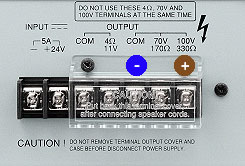100v Public Address Basics
Installing a PA System
Audio Principles & Theory
Miscellaneous
Public Address Installation Tips & Advice - 1
| Let's take our simple system used for announcements: |
 |
There are three components involved which need connecting up: The microphone, the amplifier and the loudspeaker. It is possible that the amplifier can be located local to the microphone in which case the cable and plug attached to the microphone can connect directly into the amplifier rear panel. Most commercial and industrial amplifiers have all their connections on the rear panel, so our microphone will plug into one of the microphone INPUTS at the rear. This is usually MIC 1 which is our case has a five pin DIN connector attached. (The five pins are not necessary to make the microphone function, but allow us the ability at a later date to override any music input automatically with a couple of extra wires in the cable). |
 |
| Our only other connection is to the loudspeaker, let's assume we need to wire approximately 30m to where we need the speaker, so we will use a 100v version of the horn speaker (which has a built in transformer with multi-tappings) and connect to the 100v and common terminals at the rear of the amplifier with a length of cable. |
 |
| It is important to adopt the practice of keeping loudspeaker wiring connections the same way throughout your installation, as multiple speakers need to remain in phase, i.e. wired with the same polarity throughout. To start with our small system will have just one speaker. Using a two core flexible cable such as 2182Y twin with conductor sizes of 0.75mm or 1.00mm (as our distance and speaker load are small), wire out to the horn loudspeaker which in our case will have a short flexible cable attached. At this point we need to make a joint between the two cables using a suitable terminal box or connector. It is important to treat this joint as if you were connecting two mains power cables together as the voltages on this system can theoretically get to 100v ac under certain circumstances. |
| Identify the positive and negative conductors on the speaker lead and connect them to the twin flexible cable you have installed. It is important to note here that the conductor insulation colours may not be consistent throughout the circuit, but regardless of the wire colours, keep positive to positive and likewise with negative throughout. |
| Continued |



